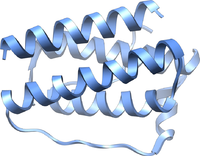
Photo from wikipedia
Abstract Objectives The current study evaluates the protective role of aqueous extract of Sterculia tragacantha leaf (AESTL) on pancreatic gene expressions (insulin, PCNA, PDX-1, KI-67 and GLP-1R) and oxidative stress… Click to show full abstract
Abstract Objectives The current study evaluates the protective role of aqueous extract of Sterculia tragacantha leaf (AESTL) on pancreatic gene expressions (insulin, PCNA, PDX-1, KI-67 and GLP-1R) and oxidative stress parameters in streptozotocin-induced diabetic rats. Methods Diabetes mellitus was induced into the experimental Wistar animals via intraperitoneal (IP) injection of streptozotocin (35 mg/kg body weight) and 5% glucose water was given to the rats for 24 h after induction. The animals were categorized into five groups of 10 rats each as follows normal control, diabetic control, diabetic rats administered AESTL (150 and 300 mg/kg body weight) and diabetic rats administered metformin (200 mg/kg) orally for two weeks. Thereafter, the animals were euthanized, blood sample collected, pancreas harvested and some pancreatic gene expressions (such as insulin, PCNA, PDX-1, KI-67, and GLP-1R)s as well as oxidative stress parameters were analyzed. Results The results revealed that AESTL significantly (p<0.05) reduced fasting blood glucose level, food and water intake, and lipid peroxidation in diabetic rats. Diabetic rats administered different doses of AESTL showed a substantial upsurge in body weight, antioxidant enzyme activities, and pancreatic gene expressions (insulin, PCNA, PDX-1, KI-67, and GLP-1R). Conclusions It can therefore be concluded that AESTL has the ability to protect the pancreas during diabetes mellitus conditions.
Journal Title: Journal of Complementary and Integrative Medicine
Year Published: 2021
Link to full text (if available)
Share on Social Media: Sign Up to like & get
recommendations!